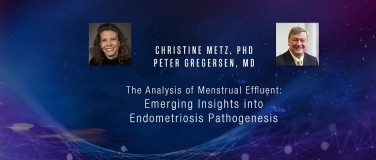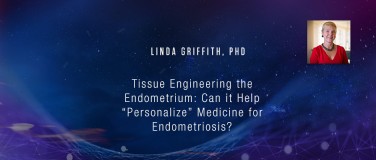Asgi Fazleabas, PhD - NOTCH1 Mediated Inflammation in Ectopic Lesions: Opportunities for Targeted Therapy
Endometriosis Foundation of America
Medical Conference 2019
Targeting Inflammation:
From Biomarkers to Precision Surgery
March 8-9, 2019 - Lenox Hill Hospital, NYC
https://www.endofound.org/medicalconference/2019
So, again, Chandler, thank you so much. I always enjoy coming to these meetings and I learn so much. I'm a basic scientist that's worked on endometriosis a number of years. And what I'd like to do today is really talk to you about one molecule. So one that we've been working on for a number of years, and just give you an idea of how we've used this whole concept of inflammation in trying to understand what its etiology might be as far as the disease is concerned.
So you heard a nice summary of this from Dr. this morning with regards to the process of inflammation and how inflammation might impact this disease, and this is a cartoon that I took from Chandler's most recent review, showing with the decimation of this tissue where it activates an aberrant immune response. And at the end of the day, something happens here where these cells, as they're deposited into the peritoneal cavity, they escape this immune surveillance that we always see what happens in other systems.
And these cells then survive, with the bottom line where they develop the lesions, and develop the lesions and maintain the lesions in this process. And there are multiple factors obviously that are potentially involved in this process. But we were really interested in Notch, so my life has been studying the role of Notch for about 15 years, particularly in the context of uterine receptivity and decidualization.
It's an early response gene that's absolutely critical for the differentiation of these stromal cells. And we've been working on it for many, many years, and we started thinking about what its implications might be in endometriosis, particularly given the fact that in macrophages, which infiltrate the cavity at the time when there is the disease, where Notch can be turned on within these macrophages, and create an extrinsic environment that results in a large inflammatory response, and releases a large number of inflammatory cytokines. Or alternatively, has an intrinsic response, where basically the inflammatory environment can act on the epithelial cells to trigger Notch regulation in a number of other cell systems.
So, our bottom line was, since we'd been studying Notch, and we had a lot of tools to start to understand Notch, to try to begin to understand whether this mechanism is really applicable to the disease. And when we think about the disease, we all know that we've been talking about it all day, about cell proliferation, EMT, angiogenesis, all being very critical, and in many cancer systems where Notch has been studied extensively, Notch contributes to all of these processes that really are involved when Notch is overexpressed. It basically maintains this tissue, this pathological tissue, and prevents it from being suppressed.
So in most cancer systems, this is exactly what happens. So we simply asked the question, does it play a role in ectopic lesion development? And we have the advantage, for those of you that know my work, we've been working with a nonhuman primate model, and, retrograde menstruation again, mimicking retrograde menstruation in the baboon model, we can create the disease essentially from day one. So we have a model, a nonhuman primate model, that gets a spontaneous disease, that we can create the disease and begin to really understand the etiology right from the point where we know we created the disease, and follow these animals long term.
So when we started to look at this, we started looking at the first expression of all four Notch receptors. There are four of them in the mammalian system, it's highly conserved from Drosophila on. Basically, the word Notch comes in the early ... 1919, when Drosophila, where Notch was knocked out, and the end result was these little notches in the wing, hence the term Notch. And it's been conserved all through evolution, and there are four Notch receptors in the mammalian system, that interact with five different ligands, and I'll focus on one or two of the ligands also.
And when we started looking by quantitative PCR, we found that Notch1, which is normally down-regulated in the eutopic endometrium in response to the disease, was highly up-regulated in the endometriotic lesions. And as you can see with regards to if you look then at animals that we focus in the mid-secretory phase, because our previous interest, and tried to understand what might be happening with regards to infertility, you can see that normally Notch is highly expressed in the mid-secretory phase, because it's critical for that decidualization response. But in both humans and baboons with the disease, you see a down-regulation in the eutopic endometrium, conversely, if you take matched ectopic lesions, again, from both humans and baboons at the same time point, you see the reverse. Where you see a huge increase in the expression Notch protein, particularly Notch1, within these endometriotic lesions.
So we started thinking about the immune response, given the fact that the literature with regards to Notch, and we began to think about what could be the inflammatory cytokines, and one of the ones really focused on was IL-6. And again, you've heard a lot of work that's been done with these inflammatory cytokines, and the role of IL-6. So again, the question we asked was, does this inflammatory environment, specifically IL-6, up-regulate Notch in these endometriotic lesions? And if it does, how does it do it, and how can we then begin to target this, to try to suppress lesion development?
So the hypothesis that we worked out was that if IL-6 binds to its receptor, it activates a series of signaling transduction pathways, but MAP kinase, P38 MAP kinase is one of the ones it phosphorylates. And essentially, based on the literature before, we knew that in the induction of interaction with IL-6, and for P38 MAP kinase, what it does, it stabilizes this unique group of E-proteins called E2A and HEB, which are a complex of proteins that are involved a large number of transcriptional mechanisms. And again, when you looked at the literature, it was evident that basically, IL-6 does regulate E2A and HEB, and these are transcription factors that are critical for the regulation of Notch, and also FOXO1, and PU.1, which arE-proteins that I've talked about, and you heard about FOXO1 earlier with work that both Hugh and Bruce presented to you.
So based on this we then asked, what is the expression level of these E-proteins, and again, using our enviable baboon model, and the human model and this is tissue from women, you can see that basically again, looking at paired tissues, eutopic endometrium and ectopic endometrium from the same animal or the same women that we get from Bruce Lessey, who's been a wonderful long-term collaborator, what we see is that E2A and Notch go up very dramatically when we pair them, particularly in the ectopic lesions. And this can then be confirmed by immunohistochemistry again, and you can see basically where you look at the control animals, you see the expression of the E-proteins and Notch, as you would expect because this is important for the initiation of decidualization.
It is lost in response to the disease in the eutopic endometrium, however in the ectopic tissue, and these are, again, matched tissues from the same animals, the same women, you find that it goes up. So, how is this regulated? And we have a cell line that some of you might be familiar with, these are immortalized endometriotic epithelial cells that are really nice to work with because we can interact, we can work on them, we can stably transfect them, and do a number of things with them. And if you just simply take these cells and treat them with Interleukin 6, what we find is that both E2A and HEB, the E-proteins go up, and this is looking at RTPCR, and one of the things about Notch is very complicated, because transcriptionally, it might be regulated in certain situations, whereas thE-protein is highly regulated, and as I'll show you in a minute.
And then you also see that Jagged 2 also goes up, and Jagged 2 is one of the major ligands of the Notch family that goes up in endometriosis. And we also see a little bit of Jagged 2, but Jagged 2 is the predominant ligand for Notch that goes up. And if you look at thE-protein again, you see the same response, but here you see that Notch protein goes up very, very dramatically, and it increases its transcriptional regulators, and its readouts and NRAPR is one of them. And then you heard about HEY2, and I could just plot HEY2 and HES1 right on the same graph, and they do the exact same thing, showing that Notch induction in response to IL-6 regulates and up-regulates downstream targets of the Notch interaction with its receptor.
So then we asked the question, if you go back to our hypothesis, what then happens when we suppress or inhibit, P38 MAP kinase? And essentially you can see that in the presence of a specific inhibitor, we inhibit the phosphorylation, decrease E2A and Notch1, both at the mRNA level, as well as at the protein level. So the question then, how is it regulated, how is it interacting, what's happening?
So, we go back and then using motif mapping, you can look at the Notch promoter region, and there are two very, very well conserved binding sites for both E2A and HEB, and again, using the 12Z cells that we've been stimulated with IL-6, and doing ChIP PCR, you can see dramatically that in the presence of IL-6, with ChIP PCR, that these two enriched regions, on the Notch promoter, are highly up-regulated in response to IL-6. Showing that there's a transcriptional regulation going on, regulated by the phosphorate forms of E-protein to drive Notch1 expression in the context of this disease.
So the question then of course is, okay, you're seeing all these up and down things, does it actually have a role? What does it do in terms of the context of our disease? So I'm going to focus only on one aspect of it, so we've also shown, which I don't have time to show you, is that when Notch1 is up-regulated, it also induces EMT, it increases cell invasiveness, and I wanna share with you the data that we've been able to show that elegantly showed you this morning, this afternoon, was the regulation of Notch to basically hypermethylate the progesterone receptor, and down-regulate the progesterone receptor in the context of progesterone resistance.
So here again, Notch1 does promote myeloid differentiation, and it does this through this transcription factor called PU.1, which is also regulated by the E-proteins. And essentially it interacts with methyltransferases, particularly DNMT3B, which is a methyltransferase, and what it does, it then drives the hypermethylation of a number of different genes. So based on that context, we simply asked, what is the expression of PU.1 in the context of the increase in Notch1 in vivo, and this is a slide that I showed you before, and you can see that if you now analyze the expression of PU.1, you see that in the ectopic tissue compare to the eutopic tissue, you get a dramatic increase in PU.1, which corresponds to the increase in Notch1.
And then if again, by immunohistochemistry you can see here, basically that we see a very similar response in the eutopic control endometrium, compared to the diseased endometrium. You see the differential expression, but if you look at the ectopic tissue, with the increase in Notch1, you see a dramatic increase in the same cells for PU.1 versus DNMT3, so now, the up-regulation of Notch, in addition to driving EMT, and driving cell invasiveness, is also up-regulating a protein that's responsible for the hypermethylation processes, and in terms of what it does to the progesterone receptor.
So when we then look at the expression of the progesterone receptor, what we find that in the presence of ... in the absence of 5ASI, and again, you heard about that earlier form, which is an inhibitor of methylation. You find that the progesterone receptors, both forms, A and B, are down-regulated, whereas if you now treat these cells in the context of the overexpression of Notch1, you find that you can restore the expression of the progesterone receptor, but you actually down-regulate PU.1. And this can then be quantified, and you can see that in the absence of 5AZA, both PRA and PRB are dramatically down-regulated. But if you now reverse this process by preventing the hypermethylation of the presence of 5AZA, you now begin to see that there is a down ... that the down-regulation of the progesterone receptor could be reversed.
So we went, then I went on to show that basically that this is really an elegant mechanism that's being regulated in the context of all these changes, and if you then look at the progesterone receptor, the promoter of both human and mouse progesterone receptor, there is a highly conserved PU.1 binding site, co-immunoprecipitation with the antibodies shows that both DNMT3B and PU.1 can be co-immunoprecipitated compared to the controls, but more importantly, if you now map the progesterone receptor from animals that we've overexpressed intracellular domain of Notch1.
So these are genetically engineered animals where we overexpressed NICD in either the epithelial cells, specifically using a lactoferrin-CRE, or in both epithelial and stromal cells using a progesterone receptor-CRE. What we find is when we look at the progesterone receptor in the animals where we overexpress the intracellular domain of Notch, that the progesterone receptor in these animals is hypermethylated. And we've gone on to show in a paper that we published in PNAS a couple of years ago that the entire progesterone cascade is highly down-regulated.
And I don't have time to show you all of the animal work in the mouse model that we've done, but basically if you take these animals where we overexpress N1ICD, selectively in the epithelial under the lactoferrin CRE, what we find is that these animals will develop lesions to a much, much greater extent than the animals that have progesterone receptor-CRE, which overexpresses the intracellular domain of Notch1, both in the epithelial cells and the stromal cells. Showing that changes in the epithelial cells from the eutopic endometrium, when deposited in the ectopic site, and you overexpress a gene that is normally down-regulated in the uterus, it really drives the development of these lesions.
So what I hope I try to show you in a very limited time, that it's a very complex mechanism as we've all talked about all day, that that inflammatory response that we see in the context of this disease, basically can drive a number of different pathways, and I've just focused on one at this point, which then brings about changes in the regulation of transcription factors that can drive Notch1 and in addition, FOXO1 and PU.1, which are also important transcriptional regulators, and genes that are important both for decidualization and lesion development.
In response, this increase in Notch1, both Jagged 1 and Jagged 2, but more particularly Jagged 2, is then overexpressed within the endometriotic lesions, and for Notch signaling to, this is a very classic juxtacrine mechanism, where the two cells have to be adjacent to one another. When they interact, you bring in both the ... the Notch receptor undergoes a series of cleavage divisions, which results in an intracellular domain of Notch, which then binds to a transcription factor RBPJ on all the Notch promoters, and this interaction allows for the driving of target genes that give response to the downstream effects of Notch. And we've been able to show using our model that if you overexpress Notch, we enhance invasion and EMT, and by up-regulating PU.1, we probably contribute to the progesterone resistance that is a hallmark of this particular disease.
So this then results in endometriosis, and we're now working with a small peptide that we've developed, that we work in collaboration with a colleague in the UK, which inhibits this complex which is so critical for Notch transcriptional regulation, and it prevents Mastermind, which is one of the transcription factors that form this complex, between RMBPG, intracellular domain of Notch, and Mastermind, to drive an activate Notch transcription genes. So by blocking this transcription, we can inhibit Notch signaling, and hopefully, we can begin to see whether this, at least this one molecule, amongst the many others that we are hoping to use, could be utilized in inhibiting endometriosis. Notch inhibition has been used extensively in cancer, it is approved for use, so there's no reason not to believe that we could start doing targeting.
And fortunately for me, I have collaborators with Anna Moore and Chris Contag at Michigan State University, who do a lot of nanoparticles targeted delivery, and that's sort of where we are going right now with this small peptide inhibitor, to try to see whether we can target using our mouse models initially, and then eventually to our baboon model, to begin to try to understand whether targeting this could be helpful in, to at least preventing, or suppressing, this disease.
So with that, again, thank you very much for having me, and let me ... I just come here and talk, these are the people that do the work. So the majority of the work that I've talked about has been done by Yong Song, who's a really wonderful post-doc in my lab. She's very quiet, but she always comes into my lab with a wealth of data every week, and I don't even have to ask her. Niraj Joshi, who's been my collaborator for many, many years, has been involved in these studies, and Ren-Wei Su, who is a former post-doc, who is now back in China with his own lab. Really did all of the elegant work with the mouse models and the ... all of the hypermethylation work that I talked about.
This all began with Lucio Miele, he's a good friend of mine for many, many, many years, when you talk about the collaboration he's the world authority on Notch, and this whole idea of trying to look at Notch in the uterus came up over a wonderful bottle of wine in Italy. So when we were thinking about, talking about what we each do, and he said, "You know, what you're seeing at the implantation site sounds just like what we see in the skin. So let's look at Notch in the uterus." 20 years later we still have a joint grant together.
So that's where it comes, and good bottles of wine always give good ideas. And of course, my dear friend Bruce, and Steve, without them I could never do any of this work, having all of the human tissues, and all my mouse work in collaboration with Jae Wook Jeong, and Tae Hoon Kim at Michigan State University. And of course, thank you to NIH, they've been very generous to me for all these years.
So thank you.










